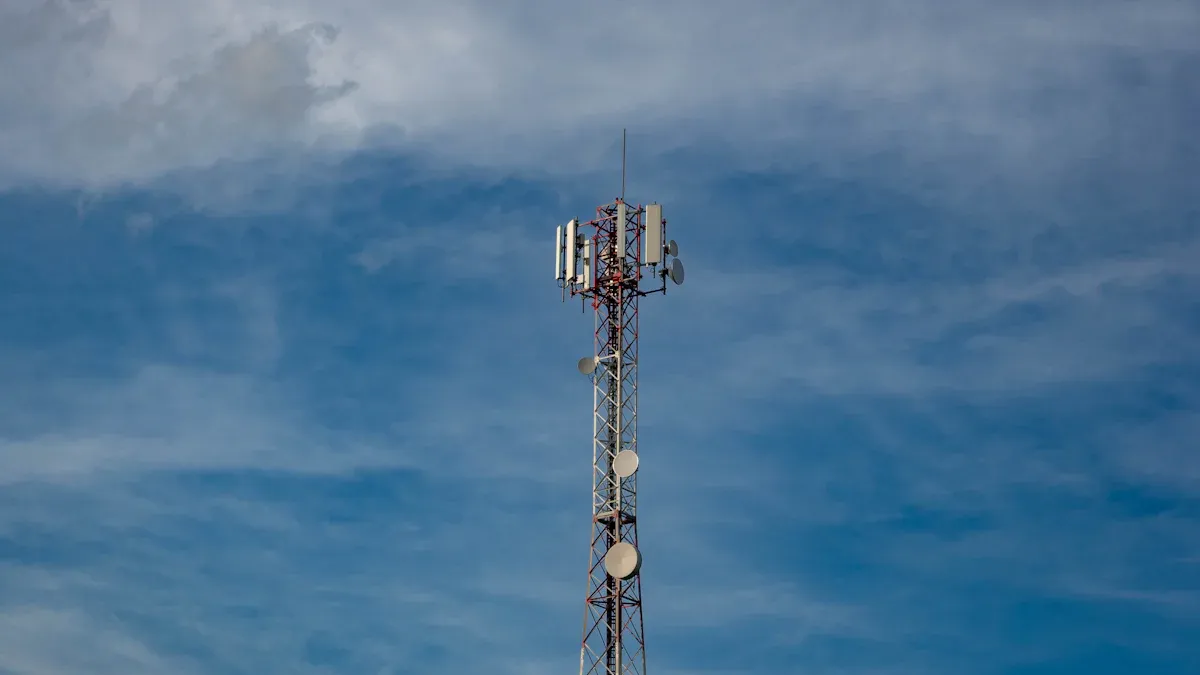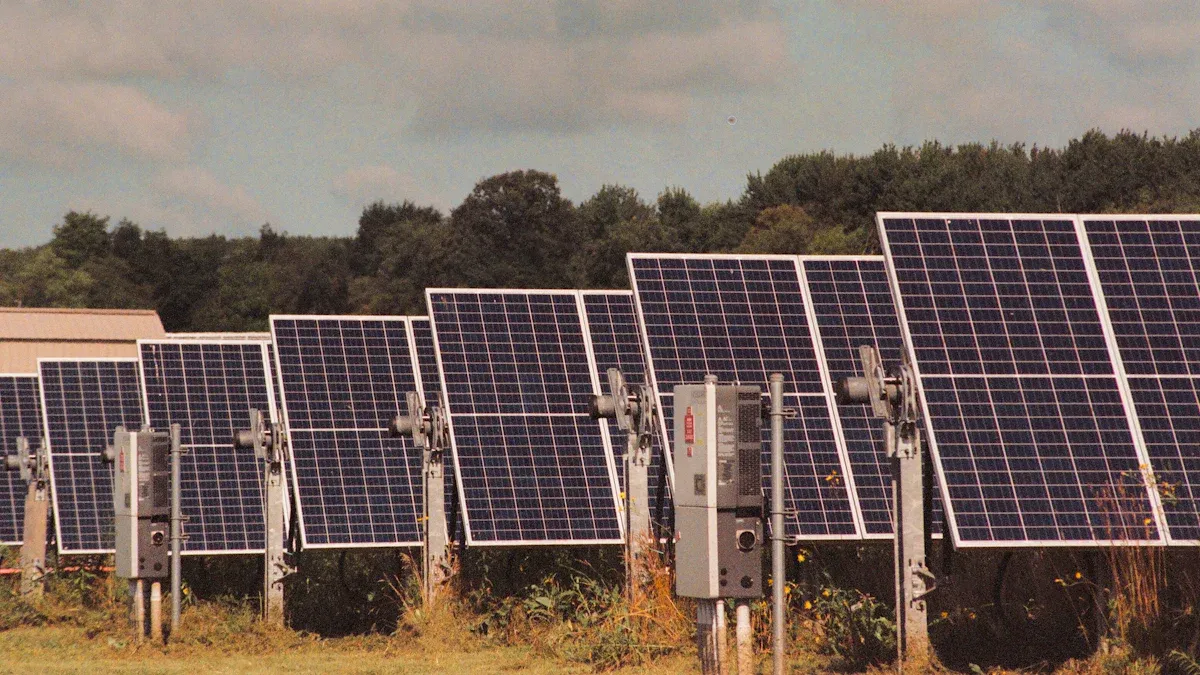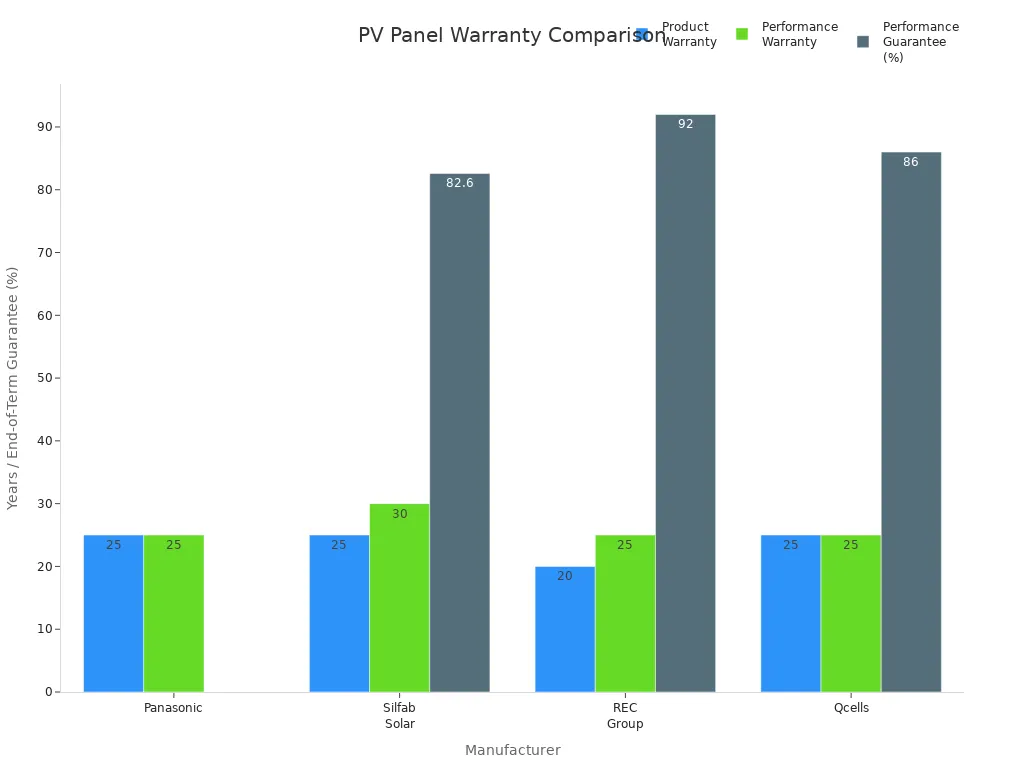How to Pick the Best PV Panels for Reliable Telecom Power

You need reliable power to keep your telecom cabinets running without interruption. Power-related failures cause about 61.8% of network outages in telecom operations, with generator and battery breakdowns leading the list. Choosing the right PV panel can cut your costs and improve uptime. Telecom operators using high-efficiency solar technologies have reported up to 20% power savings and billions in annual operational savings. By focusing on quality and efficiency, you can secure long-term performance and protect your investment.
Key Takeaways
Calculate your total energy needs accurately to size your solar panel system correctly and avoid power interruptions or extra costs.
Choose high-quality PV panels, preferably N-type, for better long-term efficiency, durability, and longer warranties.
Assess your site carefully for sunlight, shading, and space to ensure optimal panel placement and performance.
Add a 20% safety margin when sizing your system to handle power spikes and low sunlight periods, keeping your network reliable.
Perform regular maintenance like cleaning panels and inspecting structures to extend system life and maintain efficiency.
Power Needs
Load Calculation
You need to start by calculating the total load for your telecom equipment. This step helps you size your PV Panel system correctly. List every device in your telecom cabinet, note its wattage, how many you have, and how many hours each runs per day. Multiply the wattage by the hours of use for each device, then add up all the results to get your total daily watt-hours. Divide this number by the average number of full sun hours at your site to find the watts needed per hour of sunlight. Next, divide that by the output of your chosen solar module to see how many panels you need.
Step | Example Calculation |
|---|---|
Total daily watt-hours | 1000 watt-hours |
Full sun hours | 5 hours |
Watts needed per hour | 1000 ÷ 5 = 200 watts |
Solar module output | 91 watts |
Number of modules needed | 200 ÷ 91 ≈ 2.2 modules |
Accurate load calculation ensures you do not oversize or undersize your system. This approach also helps you avoid unnecessary costs and power interruptions.
Backup and Duty Cycle
You must consider how long your telecom site needs to run without sunlight. This is your backup requirement. Calculate the battery bank size by multiplying your daily watt-hours by the number of backup days you want. Adjust for battery depth of discharge and temperature. Proper battery sizing gives you enough reserve to handle cloudy days or unexpected outages. Reliable backup keeps your telecom equipment running 24/7.
Tip: Always plan for at least one to two days of backup to cover weather changes or maintenance.
Site Assessment
Assess your site before installing any PV Panel system. Check for shading, roof orientation, and available space. Measure the average daily sunlight hours at your location. These factors affect how much solar energy you can collect. A good site assessment helps you choose the right panel size and mounting method. You also reduce the risk of poor performance due to environmental issues.
Accurate load and site assessments:
Improve battery life and system reliability
Support uninterrupted telecom operations
Help you build a robust, scalable power system
PV Panel Criteria

Efficiency and Type
When you choose a PV Panel for telecom power, you need to look at both efficiency and type. Many people believe that monocrystalline panels always outperform polycrystalline ones. However, recent research in telecom applications shows that the difference is minimal. In fact, polycrystalline panels averaged 13.4% efficiency, while monocrystalline panels averaged 12.5% before cooling systems were installed. This 0.9% difference is not significant for telecom use. You can select either type based on price, availability, and space.
You should also consider N-type and P-type panels. N-type panels resist Light-Induced Degradation (LID), which means they keep their efficiency longer. P-type panels can lose up to 10% performance within weeks due to LID. N-type panels usually come with longer warranties and maintain higher efficiency over time. Here is a quick comparison:
Aspect | P-Type Solar Panels | N-Type Solar Panels |
|---|---|---|
Light-Induced Degradation (LID) | Susceptible due to boron-oxygen defects | Immune to boron-oxygen defects |
Degradation Rate | Higher annual degradation, especially early | Lower annual degradation, better long-term |
Efficiency Retention | Reduced over time due to LID | Maintains higher efficiency over time |
Lifespan | Shorter due to higher degradation | Longer due to lower degradation |
Warranty | Typically shorter (e.g., 12-25 years) | Typically longer (e.g., 20-30 years) |
Tip: For long-term reliability, N-type panels offer better performance and longer warranties, making them a smart choice for critical telecom sites.
Durability
You need a PV Panel that can withstand harsh outdoor conditions. Telecom sites often face extreme weather, from hailstorms to hurricanes. Panels with strong frames and high-quality glass resist damage better. NREL research found that only 1 out of 3,000 panels failed during a severe hailstorm when using reliable modules and components. You should also check the temperature coefficient of the panel. Panels with lower temperature coefficients perform better in hot climates, which is common at many telecom sites.
Common causes of PV panel failure in telecom environments include:
Line-line and ground faults
Shading from trees, dust, or bird droppings
Inverter and diode faults
Faulty cable connections
Battery bank failures
Damage from storms or lightning
Selecting panels from reputable brands reduces the risk of these failures. High-quality panels may cost more upfront, but they offer better durability and lower maintenance costs over time.
Size and Mounting
You must match the size of your PV Panel to your available space and power needs. For telecom cabinets with limited space, higher-efficiency panels help you get more power from a smaller footprint. Always measure your site and plan your layout before buying.
The mounting structure is just as important as the panel itself. The material you choose affects both cost and lifespan. Here is a comparison:
Feature | Galvanized Steel | Stainless Steel |
|---|---|---|
Cost | Lower upfront cost | Higher upfront cost |
Corrosion Resistance | Good for most climates | Excellent for harsh, coastal, or humid areas |
Durability | Withstands normal stress | Maintains integrity in extreme conditions |
Galvanized steel works well in moderate climates and keeps costs down. Stainless steel is best for coastal or high-humidity sites where corrosion is a bigger threat. Choosing the right mounting material protects your investment and reduces long-term maintenance.
Certification
You should always check for international certifications when selecting a PV Panel for telecom power. The IECEE Certification Body (CB) scheme, based on IEC International Standards, is the most important. This certification ensures your panels meet global safety, quality, and performance standards. The IECEE program covers solar panels, batteries, energy efficiency, and even cybersecurity. Using certified panels helps you avoid compliance issues and guarantees reliable operation across different countries.
Note: Certified panels not only meet safety standards but also make it easier to expand or upgrade your system in the future.
Sizing and Voltage
Panel Sizing
Start by sizing your PV Panel system slightly above your calculated load. Always add a 20% safety margin to your total wattage needs. This extra capacity helps you handle unexpected power spikes and prevents overheating or failures. For example, if your telecom cabinet requires 150 watts, choose panels rated between 165W and 175W. This margin ensures your system stays reliable, even when equipment power or solar heat varies. Seasonal changes, such as cloudy winters or monsoon seasons, can reduce solar energy. Oversizing your panels and battery storage helps you maintain a steady power supply during these times. You also protect your telecom site from costly outages.
Tip: Oversizing your system gives you peace of mind during periods of low sunlight or increased demand.
Voltage Matching
You must match the output voltage of your PV Panel system to your telecom equipment. Most telecom sites use either 12V DC or 220V AC systems. Check your equipment specifications before buying panels. If you mismatch voltages, you risk damaging your devices or losing efficiency. Use charge controllers and inverters designed for your system voltage. Proper voltage matching keeps your power system safe and efficient.
Check your telecom cabinet’s voltage requirements.
Select panels and inverters that match these requirements.
Use appropriate wiring and protection devices for your voltage.
Expandability
Plan for future growth when designing your PV Panel system. Telecom sites often add new equipment over time. Modular systems, such as those using microinverter technology, let you expand easily. You can add more panels and microinverters without major rewiring or redesign. This approach saves time and money when you upgrade your site. During the design phase, perform detailed electrical calculations and create layouts that allow for extra panels. Coordinate with vendors and review your plans to ensure your system can grow as your needs change.
Note: A scalable PV Panel system supports your telecom site’s long-term success and adapts to new technology.
Installation and Maintenance

Easy Setup
You can simplify PV panel installation by planning ahead and following best practices. Start by checking the available space and making sure your panels fit without blocking airflow or access to other equipment. Modular system designs work well for telecom sites because you can add or remove panels as your needs change. Always use certified professionals for installation. They align panels correctly and secure them to withstand strong winds and storms.
Here are some common installation challenges and their impacts:
Installation Challenge | Impact / Description |
|---|---|
Weather Variability | Reduced reliability during cloudy or adverse weather |
Battery Degradation | Decreased backup power over time |
High Initial Costs | Delayed return on investment |
Security Risks | Threats from theft and vandalism |
Extended Outages | Need for extra backup solutions |
You should also check that all components—solar panels, batteries, and generators—work together. Large panels may not fit in tight spaces, so measure carefully. Add security features to protect against theft and weather damage.
Maintenance Needs
Regular maintenance keeps your telecom power system reliable. Inspect steel structures at least twice a year, especially if your site faces extreme weather. In coastal or humid areas, check for corrosion and reapply anti-corrosion coatings every year. Before storms, tighten all bolts and anchors to prevent damage. Remove snow buildup in winter to avoid panel stress. After storms, inspect for any damage or loose parts.
Inspect support structures twice a year
Reapply anti-corrosion coatings annually in humid areas
Tighten bolts and anchors before storms
Clear snow in winter
Check for corrosion and wear using visual or ultrasonic tests
Evaluate for damage after storms
Tip: Regular cleaning, especially in dusty environments, helps maintain panel efficiency.
Warranty
You should always review warranty terms before choosing a PV Panel for telecom use. Leading manufacturers offer product warranties of 20 to 25 years and performance warranties up to 30 years. Lower degradation rates mean your panels will deliver more power over time. Some companies include extra coverage for labor, inverters, and racking systems. If you use certified installers, you may get additional labor warranties.
Manufacturer | Product Warranty Duration | Performance Warranty Duration | Performance Guarantee (End of Term) | Degradation Rate per Year | Additional Coverage |
|---|---|---|---|---|---|
Panasonic | 25 years | 25 years | Not explicitly stated | 0.25% - 0.50% | Panels, inverter, monitoring, racking; labor and shipping included |
Silfab Solar | 25 years | 30 years | 82.6% of original power | 0.5% | Repairs, replacements, refunds for defects |
REC Group | 20 years | 25 years | 92% of original power | 0.25% | 10-year labor warranty with certified installer |
Qcells | 25 years | 25 years | 86% of original power | 0.5% | Standard coverage; no special labor warranty |

Note: Longer warranties and lower degradation rates protect your investment and ensure reliable telecom power for years.
Common Mistakes
Undersizing
You might think a smaller solar setup saves money, but undersizing your system creates bigger problems. When your panels cannot meet the energy demand, your batteries work harder and wear out faster. This leads to more frequent replacements and higher maintenance costs. Network uptime drops because your equipment does not get enough power, especially during cloudy days or peak usage. You risk unexpected outages and expensive repairs. Always size your system with a safety margin to avoid these issues.
Tip: Oversize your system by at least 20% to protect your batteries and keep your network running smoothly.
Ignoring Environment
Many installers overlook the impact of the environment on solar performance. If you place panels in shaded areas or locations with frequent dust, snow, or bird droppings, you lose valuable sunlight. Poor site selection reduces your system’s output and reliability. You should always assess your site for shading, orientation, and weather risks before installation. In coastal or humid regions, corrosion can damage mounting structures and wiring. Regular inspections and anti-corrosion treatments help prevent long-term damage.
Common environmental mistakes include:
Selecting a site with shading from trees or buildings
Failing to clean panels in dusty or snowy areas
Ignoring corrosion risks in humid or coastal climates
Overlooking Quality
Choosing cheap or mismatched components often leads to system failure. You might feel tempted to buy secondhand or DIY panels, but these usually have lower efficiency and shorter warranties. Mixing different panel types, voltages, or brands causes uneven degradation and power loss. Improper wiring or poor installation practices also limit your system’s performance. Reliable telecom power depends on using high-quality, compatible parts from reputable manufacturers.
Note: Always match your solar panels, batteries, and controllers for best results. Avoid shortcuts that compromise reliability.
Most frequent mistakes to avoid:
Using panels from different manufacturers or with different voltages
Installing panels in separate roof areas but connecting them to a single inverter
Not matching solar arrays with the right batteries and charge controllers
To choose the best solar solution for your telecom cabinet, follow these steps:
Assess your roof condition for solar readiness.
Consult experts about your energy needs and installation options.
Get a plan tailored to your site and goals.
Schedule installation after approval.
Start using your new system.
Always size your system accurately, select quality components, and consider site conditions. Plan for future expansion so your power system can grow with your network and stay reliable.
FAQ
How do you determine the right number of PV panels for your telecom site?
Start by calculating your total daily energy use in watt-hours. Divide this by the average sun hours at your location. Add a 20% safety margin. This gives you the minimum number of panels you need.
What maintenance tasks keep your PV panels working efficiently?
You should clean panels regularly to remove dust and debris. Inspect mounting structures for corrosion or loose bolts. Check wiring and connectors for damage. Schedule inspections twice a year for best results.
Can you mix different brands or types of PV panels in one system?
Avoid mixing brands or types. Different panels may have varying voltages and degradation rates. This can reduce efficiency and cause system imbalance. Always use matching panels for reliable performance.
What certifications should you look for when choosing PV panels?
Look for IEC and IECEE certifications. These prove your panels meet international safety and quality standards. Certified panels help you avoid compliance issues and ensure long-term reliability.
See Also
Steps To Guarantee Stable Power For Telecom Cabinets
Solar Energy Storage Solutions Designed For Telecom Cabinets
Essential Facts About Power Supply Characteristics In Telecom
Guide To Selecting Optimal Outdoor Mounts For Telecom Cabinets
Integrated Grid-Tied Solar Inverter And Battery Setup For Telecom
CALL US DIRECTLY
86-13752765943
3A-8, SHUIWAN 1979 SQUARE (PHASE II), NO.111, TAIZI ROAD,SHUIWAN COMMUNITY, ZHAOSHANG STREET, NANSHAN DISTRICT, SHENZHEN, GUANGDONG, CHINA


